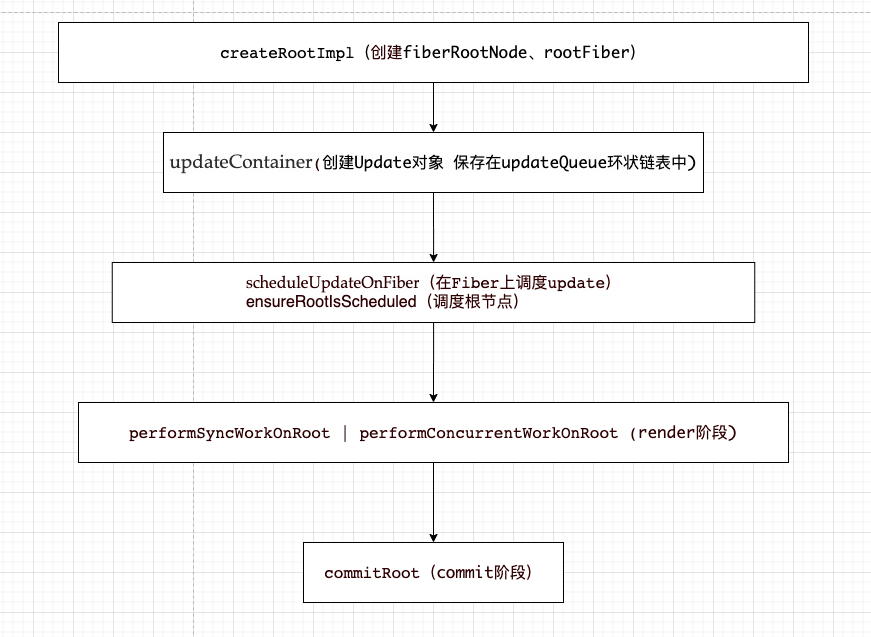react中的入口函数的模式


legacy
1
2
3
4
5
6
7
8
9
10
11
12
13
14
15
16
17
18
19
20
21
22
23
24
25
26
27
28
| render() =>
legacyRenderSubtreeIntoContainer() => {
legacyCreateRootFromDOMContainer() => {
var shouldHydrate = forceHydrate || shouldXXXHeuristic(container);
return createLegacyRoot(container, shouldHydrate? { hydrate: true } : undefined) => {
return new ReactDOMBlockingRoot(container, LegacyRoot, options) => {
this._internalRoot = createRootImpl(container, tag, options) => {
var root = createContainer(container, tag, hydrate) => {
return createFiberRoot(containerInfo, tag, hydrate) => {
var root = new FiberRootNode(containerInfo, tag, hydrate)
var uninitializedFiber = createHostRootFiber(tag)
root.current = uninitializedFiber
uninitializedFiber.stateNode = root
initializeUpdateQueue(uninitializedFiber)
return root
}
}
return root
}
}
}
}
}
|
创建Update对象
对于HostRoot或者ClassComponent会使用initializeUpdateQueue创建updateQueue,然后将updateQueue挂载到fiber节点上
1
2
3
4
5
6
7
8
9
10
11
12
| function initializeUpdateQueue(fiber) {
var queue = {
baseState: fiber.memoizedState,
firstBaseUpdate: null,
lastBaseUpdate: null,
shared: {pending: null},
effects: null
}
fiber.updateQueue = queue
}
|
然后我们进入updateContainer函数
updateContainer
1
2
3
4
5
6
7
8
9
10
11
12
13
14
| function updateContainer(element, container, parentComponent, callback) {
var lane = requestUpdateLane
var update = createUpdate(eventTime, lane)
update.payload = { element: element }
enqueueUpdate(current, update)
scheduleUpdateOnFiber(current, lane, eventTime)
return lane;
}
|
1
2
3
4
5
6
7
8
9
10
11
12
| function createUpdate(eventTime, lane) {
var update = {
eventTime: eventTime,
lane: lane,
tag: UpdateState,
payload: null,
callback: null,
next: null
};
return update;
}
|
1
2
3
4
5
6
7
8
9
10
11
12
13
14
15
16
17
18
|
function enqueueUpdate(fiber, update) {
updateQueue = fiber.updateQueue;
sharedQueue = updateQueue.shared
pending = sharedQueue.pending
if(pending === null) {
update.next = update
} else {
update.next = pending.next
pending.next = update
}
sharedQueue.pending = update
}
|
scheduleUpdateOnFiber
1
2
3
4
5
6
| function scheduleUpdateOnFiber(fiber, lane, eventTime) {
if (lane === SyncLane) {
performSyncWorkOnRoot(root)
}
}
|
concurrent
起点 createRoot
创建根节点
1
2
3
4
5
6
| function createRoot(container, options) => {
return new ReactDOMRoot(container, options) => {
this.internalRoot = createRootImpl(container, ConcurrentRoot, options)
}
}
|
ReactDOMRoot.prototype.render
1
2
3
4
5
6
| ReactDOMRoot.prototype.render = ReactDOMBlockingRoot.prototype.render = function (children) => {
var root = this.internalRoot
updateContainer(children, root, null, null)
}
|
1
2
3
4
5
6
7
8
9
10
11
12
13
14
15
16
17
18
19
20
21
22
23
24
25
26
27
28
29
30
31
32
| function scheduleUpdateOnFiber(fiber, lane, eventTime) {
if (lane === SyncLane) {
performSyncWorkOnRoot(root);
} else {
ensureRootIsScheduled(root, eventTime);
}
ensureRootIsScheduled(root, currentTme) => {
var nextLanes = getNextLanes(root, root === workInProgressRoot ? workInProgressRootRenderLanes : NoLanes);
if (nextLanes === NoLanes) {
}
if (newCallbackPrPriority === SyncLanePriority) {
scheduleCallback(performSyncWorkOnRoot.bind(null, root))
} else if (newCallbackPrPriority === S yncBatchedLanePriority) {
scheduleCallback(ImmediatePriority$1, performSyncWorkOnRoot.bind(null, root))
} else {
var schedulerPriorityLevel = lanePriorityToSchedulerPriority(newCallbackPrPriority)
scheduleCallback(schedulerPriorityLevel, performConcurrentWorkOnRoot.bind(null, root))
}
}
}
|
两种模式的不同点
- createRootImpl中传入的第二个参数不一样 一个是LegacyRoot一个是ConcurrentRoot
1
2
3
4
5
6
7
| create(container, tag, options)
export type RootTag = 0 | 1 | 2
export const LegactRoot = 0
export const BlockingRoot = 1
export const ConcurrentRoot = 2
|
- requestUpdateLane中获取的lane的优先级不同
- 在函数scheduleUpdateOnFiber中根据不同优先级进入不同分支,legacy模式进入performSyncWorkOnRoot,concurrent模式会异步调度performConcurrentWorkOnRoot

